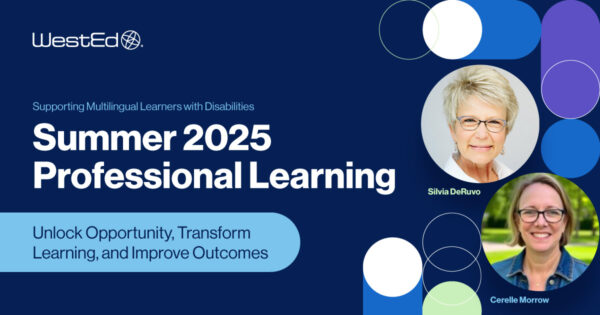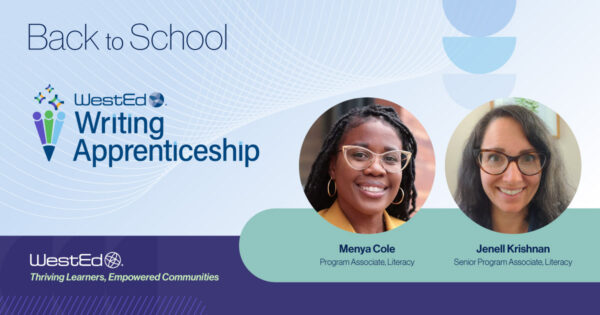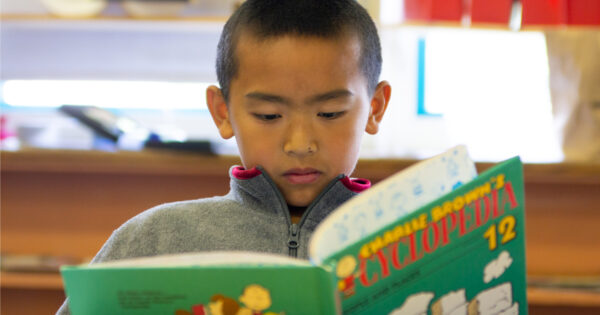
May 29, 2025
As the number of students who are Newcomers—recently arrived immigrants to the United States who attend school in grades K–12—grows nationwide, educators seek effective ways to teach language and subject-area content.
WestEd’s Quality Teaching for English Learners (QTEL) employs a sociocultural and collaborative approach to instruction, a model that has been proven to increase classroom engagement. And this summer, hundreds of educators will attend QTEL’s professional development institutes to develop the expertise to engage English Learners, including Newcomer students, in deep, generative learning.

Lee Hartman, Senior Program Associate with WestEd’s English Learners and Migrant Education Services, will keynote and facilitate the Building the Base: Newcomer Literacy institute. In this Q&A, Hartman talks about how the wealth of assets that Newcomer students bring with them makes them more than capable of engaging in rigorous instruction. He also discusses the QTEL approach to teaching English Learners and what educators can look forward to in this summer’s institutes.
Note: This conversation has been edited for clarity and length.
Traditionally, students, including Newcomer students, have learned language before learning rigorous content. However, students can do both simultaneously through high-challenge and high-support tasks.
There’s no time, particularly at the secondary level, to pause content-area learning for 2 or 3 years. So, we must work with our students in accelerated ways. Waiting for them to be “ready” wastes time and doesn’t honor who they are.
Consider the perspective of a Newcomer student. They’re navigating life in a new country and facing many 1st-year immigrant experiences that provide them with so much to share. They’re learning and growing every day. However, a class that only focuses on grammar and the rote memorization of vocabulary can feel disconnected from their real-life experiences.
As human beings, we enjoy abstract and deep thought. We love making connections and finding meaning in the world around us. Why wouldn’t we want to offer that experience to our students?
A basic example in Newcomer curricula is teaching family words like mom, dad, stepmother, and cousin. While this vocabulary is essential for functioning in an English-speaking society, the concept of the family is deep and personal. Instead of just translating words like mother and father, we explore their meaning: What does the word mean to you? How did this person make you who you are?
Our approach is sociocultural and collaborative. We focus on oracy and speaking. Through speaking and listening to peers, students learn significantly and gain the ability to navigate the world in any language. They develop their voice and agency, which is crucial.
Given everything happening in their lives, they need to know not just any words but the ones that they can use to express their minds and how they can affect the world around them with those words.
Newcomers can have an array of formal education in their backgrounds, so educators must navigate that. Again, this is where high support plays a crucial role. These assets, which I would define as life lessons, include adapting to change, demonstrating tenacity, and understanding how to navigate different systems and what actions to take. They are also figuring out who they are, where they fit in, and how to use their voices.
I believe that moving to a new culture, learning a new language, and adapting to a new political system prepares them for life in a way that many people never encounter or only experience much later in life.
Also, even if they don’t speak perfect English and even if some students come to the classroom and aren’t strong in reading and writing, they bring with them linguistic knowledge in their first language. They use it every day to communicate, so they can compare how that works with another language because they’re learning English. This bilingualism prepares them for learning anything new.
The biggest shift that I ask teachers to embrace is that you are not a language teacher. You’re teaching big concepts and ideas, and language is a tool to do that.
When you talk with educators about how their students are capable—and if we just offer them these learning opportunities and then support them so that they can do it—it’s really hard to take offense to that. People understand this on a human level. For many of us as educators, we enter education to do just that.
Newcomer teachers are [in the institutes] to learn and do the work. But sometimes I’ll get questions like, “You don’t have them memorize all the words?” or “You don’t do grammar drills?”
During the institute, we go through the lessons; then we review the lessons and how to implement them in the classroom. However, we also have crucial moments when we pause and just talk about concepts. We have also identified common misconceptions teachers have about working with newcomers, one of which relates to your first question: that students have to have the language skills to be ready for content learning. Or, for example, if a student makes a mistake and I don’t correct it a million times, it will fossilize, and they’ll always speak incorrectly for the rest of their lives. These misconceptions have done much harm over the years and need to be addressed.
The biggest shift that I ask teachers to embrace is that you are not a language teacher. You’re teaching big concepts and ideas, and language is a tool to do that. So, you have to teach the language, but that’s never the goal. That’s why we have these institutes—learning how to make that happen with the necessary support is the tricky part where we have to build our expertise.
My goal is never that a Newcomer student learn the word red. I want to know if they understand what an artist was trying to communicate when they use the color red. When they look at a piece of art, do they put themselves into it? Or perhaps that person is trying to manipulate me in advertising. Those big ideas. My students would give me a sentence answer or a four-word answer, but I knew there was a two-to-three-paragraph answer in their heads. So, it’s the English that’s stopping them. That’s why I have to focus on English, just so they can express their ideas, but my goal is always the idea first.
It’s great to see that QTEL attendees learn how to design and sequence lessons.
We aim to ensure that a large part of the professional learning is focused on having teachers engaged in what the lessons and tasks look like in the classroom. For example, we’ll talk about oracy. I’ll present the underlying theoretical information. Then I’ll give an example of what it looks like in implementation, and participants will engage in a lesson. At the end, we reflect and ask, “Who did you talk to? What did you talk about? How did you learn through talk?” This helps participants understand how it works.
We provide specific examples throughout the institute, always allowing time for reflection. On the last day, we encourage participants to think about lesson ideas, sketches, and activities to create a lesson they can use in their classrooms. Since this is a summer institute, many choose to focus on their initial lessons for August and consider, “Well, if you are going to design lessons in this way, what might you add or change after these 4 and a half days together?”
I also sit down with them individually to discuss their lessons. And they can get feedback from other participants.
This makes sense; the institutes describe how participants can adopt this teaching approach in their classrooms and adapt it to their style.
When you really delve into QTEL, it’s an approach. And the institute follows that same approach. It’s the approach we use with kindergartners, and it’s the approach we use with teachers and PhD candidates as well.
One of our big tenets is that participation in activity is central to the development of knowledge. If teachers are going to learn how to teach this way, they have to participate in this way of teaching. So that’s a major focus of the 5 days.
My personal story that I share sometimes is that I was a pretty good teacher—I had my classroom management down, the students liked me, and there was parent involvement. I worked at a school for Newcomers. It was great. It wasn’t like I had one shining-light, turnaround moment, but when I came into this way of teaching, it just made sense to me at the beginning. But I also thought, “I’m not sure if my students can do it.”
So, I had the same misconception we discussed earlier. I didn’t realize that I didn’t believe my students could do some things. If someone had asked me, I would have said, “Yeah, my students are capable of doing anything.” So, [QTEL] said, “Well, then teach them this.” But I thought, “Oh, they’re not ready. They don’t have enough language yet.”
I had taught long enough to know that various initiatives usually come through schools, last for a year or 2, and then fade away. I remember distinctly thinking, “I’m going to try this in my classroom. It’s not going to work, and then I’ll tell my principal, ‘You see? I tried and the students can’t do it.’”
As you can tell, my students proved me wrong, and I have been using [the QTEL] approach ever since.










